Congratulations - you have completed .
You scored %%SCORE%% out of %%TOTAL%%.
Your performance has been rated as %%RATING%%
Your answers are highlighted below.
Question 1 |
Which example from the list below illustrates the two species that likely share the most recent common ancestor?
Hawaiian silversword plants vary dramatically in their appearance. Some are tall, twiggy trees and others are dense, ground-hugging shrubs. Yet, the silverswords’ genes are very similar to each other | |
Wings of birds and insects perform the same function, flying or movement through the air | |
New World vultures (Cathartidae family) and Old World (Accipitridae family) vultures look very similar, both have featherless necks and hears, and feed on carrion. New World vultures use only visual senses to hunt for prey, whereas Old World vultures use the sense of vision as well as smell for preying purposes | |
Penguins and fish both have fin-like structures to help them navigate through their aquatic environments |
Question 1 Explanation:
The correct answer is (A). In general, if an organism shares a very similar morphological characteristic or similar DNA sequences with another organism, they are more likely to be closely related than organisms with different structures and DNA sequences. However, in some cases the morphological differences can be great and genetic differences can be small (or vise-versa). Comparing traits in several different ways, such as fossil evidence and molecular comparisons can help determine ancestry. All of the above examples, except for (A), show analogous structures, which do not share common ancestry. An organism’s evolutionary history is documented in its genome.
Question 2 |
Look at the four phylogenetic trees below. Which tree shows a different evolutionary history for taxa A–D than the other three trees?
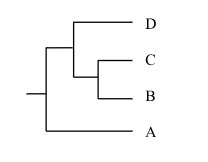 | |
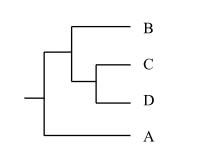 | |
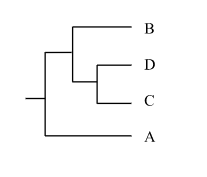 | |
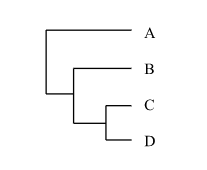 |
Question 2 Explanation:
The correct answer is (A). The phylogenetic tree in (A) shows the different pattern of evolutionary history. In answers (B), (C) and (D), species “C” and species “D” are sister taxa. In answer (A), species “C” and species “B” are sister taxa.
Question 3 |
Based on this phylogenetic tree, which statement is not true?
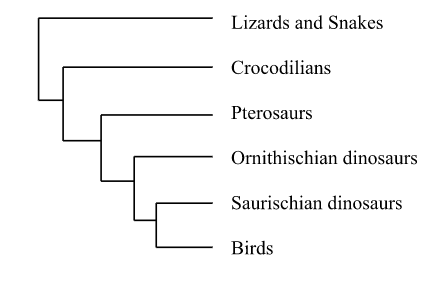
Crocodilians are a sister group to the group containing pterosaurs, ornithischian dinosaurs and saurischian dinosaurs | |
Orithischian dinosaurs and saurischian dinosaurs are more closely related to birds than lizards and snakes | |
The lineage leading to the lizards and snakes was the first to diverge from the other lineages | |
Crocodilians are more closely related to ornithischian dinosaurs than lizards |
Question 3 Explanation:
The correct answer is (D). Phylogenetic trees are branching diagrams that show the evolutionary history of a group of organisms. Phylogenetic trees show relationships between groups of organisms. These relationships are shown as branch points, where each branch point represents the divergence of two evolutionary lineages from a common ancestor. Sister taxa are groups of organisms that share an immediate common ancestor. This tree shows that crocodilians are more closely related to lizards and snakes, than to ornithischian dinosaurs, which are not adjacent to the crocodilians on the tree.
Question 4 |
In zebras, the striped pattern is determined by a series of genes that “turn on” the production of melanin (a dark pigment) on only certain parts of the body. This timing differs between species, and explains why different species of zebras have different types of striping. For example, Plains zebras have relatively wide stripes, yet Grevy’s Zebra has relatively narrow stripes.
This is an example of:
Homeotic genes | |
Paedomorphosis | |
Heterochrony | |
Evolutionary novelties |
Question 4 Explanation:
The correct answer is (C). Heterochrony is an evolutionary change in the rate or timing of developmental events.
Question 5 |
Which of the following lists the hierarchical classification system from most to least inclusive?
Domain, Kingdom, Phylum, Class, Order, Family, Genus, Species | |
Phylum, Domain, Kingdom, Class, Order, Family, Genus, Species | |
Domain, Species, Genus, Family, Order, Class, Phylum, Kingdom | |
Kingdom, Phylum, Class, Order, Family, Genus, Species, Domain |
Question 5 Explanation:
The correct answer is (A). Domain is the most inclusive category, and species is the least.
Question 6 |
Which domain has the following characteristics:
- Single-celled
- No internal membranes
- May be aerobic or anaerobic
- Contain peptidoglycan in their thick, rigid cell walls
- No introns
Domain Archaea | |
Domain Bacteria | |
Domain Eukarya | |
Domain Prokarya |
Question 6 Explanation:
The correct answer is (B). Domain Bacteria has the characteristics described. Domain Archaea differs in that it may Archaean cells contain introns in some genes and they do not have peptidoglycan. Domain Eukarya includes all organisms with a nucleus, internal organelles and no peptidoglycan. Eukarya includes the following kingdoms: Protista (a polyphyletic grouping), Fungi, Plantae, and Animalia. Prokarya was the taxon that contained all prokaryotic organisms, has been split into two domains: Archaea and Bacteria.
Question 7 |
Which kingdom has the following characteristics:
- May be either heterotrophs or autotrophs
- May move by a variety of methods including pseudopods, cilia or flagella
- Some carry serious diseases such as malaria
- Include the widest variety of eukaryotic organisms
Animalia | |
Fungi | |
Plantae | |
Protista |
Question 7 Explanation:
The correct answer is (D). Kingdom Protista have the characteristics listed above. Kingdom Animalia are all heterotrophic and do not move by the same mechanisms. Kingdom Fungi are also heterotrophic and immobile. Kingdom Plantae are immobile and most are autotrophic.
Once you are finished, click the button below. Any items you have not completed will be marked incorrect.
There are 7 questions to complete.
|
List |
Next Practice Test:
Life Continues to Evolve >>
AP Biology Main Menu >>
